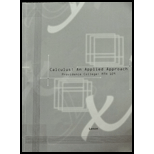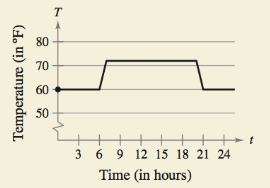
Concept explainers
How do You See it? An electronically controlled thermostat in a home is programmed to lower the temperature automatically during the night. The temperature in the house T (in degrees Fahrenheit) is given in terms of t, the time in hours on a 24-hour clock (see figure).

(a) Explain why T is a function of t.
(b) Approximate T(4) and T(15).
(c) The thermostat is reprogrammed to produce a temperature H for which
How does this change the temperature?
(d) The thermostat is reprogrammed to produce a temperature H for which
How does this change the temperature?
Trending nowThis is a popular solution!

Chapter 1 Solutions
Calculus: An Applied Approach (Providence College: MTH 109)
Additional Math Textbook Solutions
College Algebra (Collegiate Math)
Precalculus: A Unit Circle Approach (3rd Edition)
A First Course in Probability (10th Edition)
Elementary Statistics (13th Edition)
Mathematics for the Trades: A Guided Approach (11th Edition) (What's New in Trade Math)
Finite Mathematics for Business, Economics, Life Sciences and Social Sciences
- Repeat the previous exercise to find the formula forthe APY of an account that compounds daily. Usethe results from this and the previous exercise todevelop a function I(n)for the APY of any accountthat compounds n times per year.arrow_forwardUse your schools library, the Internet, or some other reference source to find real-life applications of approximations of functions.arrow_forwardThe half-life of plutonium-244 is 80,000,000 years. Find function gives the amount of carbon-14 remaining as a function of time, measured in years.arrow_forward
- Earthquake the graph shows the vertical acceleration of the Ground from the 1994 Northridge earthquake in Los Angles, as measured by a seismograph. (Here t represents the time in seconds.) (a) At what time t did the earthquake first make noticeable movement of the Earth? (b) At what time t did the earthquakes seem to end? (c) At what time t was the maximum intensity of the earthquake list reachedarrow_forwardA forest fire leaves behind an area of grass burned in an expanding circular pattern. If the radius of the circle of burning grass is increasing with time according to the formula r(t)=2t+1 , express the area burned as a function of time, t (minutes).arrow_forwardIf you travel 300 miles on the first day and then drive v miles per hour for t hours on the second day, then the total distance traveled over the teo-day period is given by d=300+vt miles. Use a formula to express v as a function of d and t for this two-day event.arrow_forward
- Algebra & Trigonometry with Analytic GeometryAlgebraISBN:9781133382119Author:SwokowskiPublisher:Cengage
 College AlgebraAlgebraISBN:9781305115545Author:James Stewart, Lothar Redlin, Saleem WatsonPublisher:Cengage Learning
College AlgebraAlgebraISBN:9781305115545Author:James Stewart, Lothar Redlin, Saleem WatsonPublisher:Cengage Learning College Algebra (MindTap Course List)AlgebraISBN:9781305652231Author:R. David Gustafson, Jeff HughesPublisher:Cengage Learning
College Algebra (MindTap Course List)AlgebraISBN:9781305652231Author:R. David Gustafson, Jeff HughesPublisher:Cengage Learning 
 Glencoe Algebra 1, Student Edition, 9780079039897...AlgebraISBN:9780079039897Author:CarterPublisher:McGraw Hill
Glencoe Algebra 1, Student Edition, 9780079039897...AlgebraISBN:9780079039897Author:CarterPublisher:McGraw Hill Functions and Change: A Modeling Approach to Coll...AlgebraISBN:9781337111348Author:Bruce Crauder, Benny Evans, Alan NoellPublisher:Cengage Learning
Functions and Change: A Modeling Approach to Coll...AlgebraISBN:9781337111348Author:Bruce Crauder, Benny Evans, Alan NoellPublisher:Cengage Learning





